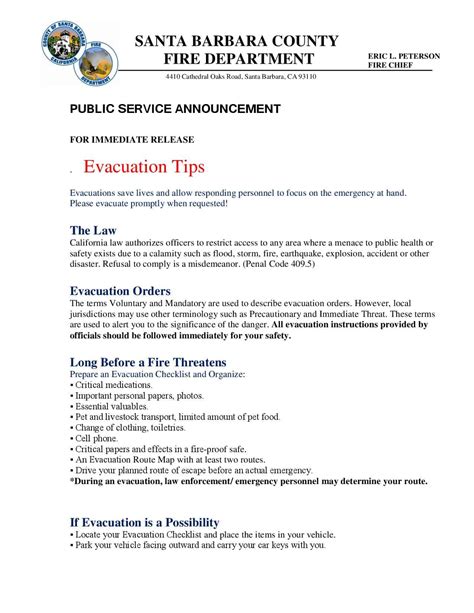The threat of wildfires is an ever-present concern for residents and visitors of Santa Barbara, a city nestled in the picturesque coastal mountains of California. With its unique geography, characterized by rugged terrain and dry vegetation, Santa Barbara is vulnerable to devastating fires that can spread rapidly. In recent years, the region has experienced its share of catastrophic wildfires, emphasizing the importance of being prepared and knowing how to react in the event of an emergency. This guide is designed to provide critical information on evacuation routes, safety tips, and preparation strategies to help individuals navigate the challenges posed by wildfires in Santa Barbara.
Understanding the Risks
Before diving into the specifics of evacuation and safety, it’s crucial to understand the risks associated with wildfires in Santa Barbara. The region’s dry seasons, coupled with strong winds, can turn even a small spark into a massive inferno. Areas with dense vegetation are particularly at risk, and the proximity of wildland-urban interfaces increases the danger to both residents and firefighters. Being aware of these risks is the first step in preparing for the worst.
Preparation is Key
Preparation is the cornerstone of safety when it comes to wildfires. Here are several steps residents and visitors can take to prepare for a potential wildfire:
Create a Defensible Space: Clearing flammable vegetation from around homes and buildings can significantly reduce the risk of them catching fire. The State of California recommends creating a defensible space of at least 100 feet around structures.
Develop an Emergency Plan: Having a clear plan in place can save precious time during an evacuation. This includes knowing evacuation routes, having a meeting point outside the fire area, and designating an out-of-area contact person.
Stay Informed: Stay updated with local news and emergency alerts. Technology such as emergency alert systems and mobile apps can provide critical information in real-time.
Pack an Emergency Kit: An emergency kit should include essentials like water, non-perishable food, first aid supplies, and a battery-powered radio. It’s also crucial to have important documents, medications, and a change of clothes ready to go.
Evacuation Routes and Procedures
In the event of a wildfire, evacuation routes can become congested quickly. Knowing the evacuation procedures and having a plan can make all the difference:
Stay Calm and Follow Instructions: Panic can lead to poor decision-making. Stay calm, follow the instructions of local authorities, and evacuate the area promptly if ordered to do so.
Know Your Evacuation Zone: Santa Barbara is divided into evacuation zones. Knowing which zone you are in can help you understand when it’s time to evacuate.
Alternate Routes: Have knowledge of alternative routes in case primary evacuation routes are blocked. This might include back roads or other less traveled paths.
Leave Early: Do not wait for the last minute to evacuate. Fires can spread rapidly, and roads can become impassable quickly.
Safety Tips for Evacuation
During an evacuation, safety should always be the top priority:
Stay Alert: Keep an eye out for falling debris, downed power lines, and other hazards.
Protect Yourself from Smoke: Wildfire smoke can be harmful, especially for individuals with respiratory issues. Wear a mask rated N95 or better to filter out fine particles.
Keep Phone Charged: A charged phone can be a lifeline during an emergency. Keep it charged, and consider bringing a portable charger.
Follow Traffic Instructions: Emergency responders and traffic management teams work hard to keep evacuation routes open and safe. Follow their instructions, and be patient.
Community Resources
The community of Santa Barbara comes together during times of crisis, offering various resources to those affected by wildfires:
Emergency Shelters: Local shelters provide a safe place for evacuees. These shelters often offer basic necessities like food, water, and restroom facilities.
Animal Shelters: For those with pets, knowing where to take them during an evacuation is crucial. Local animal shelters can provide temporary housing for pets.
Mental Health Support: The trauma of a wildfire can have a profound psychological impact. Santa Barbara offers mental health support services for those affected by wildfires.
Conclusion
The threat of wildfires in Santa Barbara is a harsh reality, but with the right information, preparation, and mindset, individuals can significantly reduce their risk and ensure their safety. Understanding the risks, being prepared, knowing evacuation routes, and following safety tips are all critical components of a comprehensive approach to wildfire safety. By working together and looking out for one another, the community of Santa Barbara can face the challenges posed by wildfires with resilience and strength.
FAQ Section
What are the most critical factors in creating a defensible space around my home in Santa Barbara?
+Clearing flammable vegetation, maintaining a clean yard free of debris, and using fire-resistant materials for roofing and siding are crucial. The State of California provides specific guidelines for defensible space creation, which includes maintaining a 100-foot radius around structures free from flammable materials.
How do I stay informed about wildfire risks and evacuations in Santa Barbara?
+Registering for emergency alerts from local authorities, following local news and fire department social media accounts, and using mobile apps designed for emergency alerts can keep you informed. Additionally, have a battery-powered radio on hand in case of a power outage.
What should I include in my emergency kit in case of a wildfire evacuation?
+Essentials for an emergency kit include water (at least one gallon per person per day), non-perishable food, first aid supplies, a battery-powered radio, a flashlight, and important documents (e.g., insurance policies, identification). Don’t forget medications, a change of clothes, and a charger for your phone.



